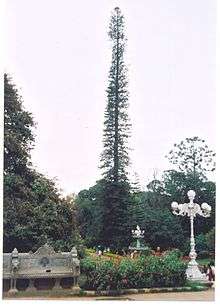Bagh (garden)
Bāgh (Persian: باغ) usually translated as garden, refers to an enclosed area with permanent cultures (many types of trees and shrubs) as well as flowers. It usually has Irano-Islamic architectural elements. Also known as Bageecha or Bagicha.

Etymology

Bāgh is a word common to the Iranian languages Persian,[1] Pashto, Kurdish, Lurish, and means garden and orchard, specifically one containing fruit- and flower-bearing trees.[2] In Persian, the plural of bāgh is bāgh-hā (باغها or باغها) and in Kurdish, baxan (بيغان).
The word bāgh is encountered in both Pahlavi and Sogdian.[2] In Farizandi, Gilaki, Shahmirzadi and Sorkhei bāk, and in Natanzi bāg stand for bāgh[2] (see Dialects of Central Iran).
Use in place names
The word bāgh is often met in place-names in conjunction with a word in which the notion of garden is already implicit, such as Bāgh-e Ferdows, Bāgh-e Jannat and Bāgh-e Rezvān.[3]
Bāgh is also a constituent part of the place-name Karabagh, which is often said to mean 'black garden' but probably means 'many gardens.'[4]
Borrowings
The Iranian word has been borrowed by Urdu as well as other Indian languages, Turkish (Baug), Azerbaijani, Georgian language (ბაღი), and Armenian. The Russian language utilizes the words bakhcha (бахча), from the Persian word bāghche (Persian: باغچه meaning small garden) to designate melons and gourds.
Elements
The elements of a Bāgh consist of the following:
Natural conditions and materials:
Man-made elements:
Important bāghs
- Bāgh-e Ferdows
- Bāgh-e-Jinnah
- Bāgh-e-Fin
- Jallianwala Bagh
- Chahar Bagh
- Sikandar Bagh
- Hazuri Bagh
- Bagh-e Melli
- Khusro Bagh
- Ram Bagh
- Lal Bagh
See also
Notes and references
- ↑ W. Eilers; M. Bazin; W.L. Hanaway; N.H. Dupree. "Bāḡ". Encyclopaedia Iranica. Retrieved 2008-04-15.
- 1 2 3 Dehkhoda Dictionary (Loghat'nāmeh-ye Dehkhoda), Third Edition (Tehran University Press, 2006).
- ↑ Bāgh-e Rezvān is the name of a cemetery in Esfahan.
- ↑ E.M. Pospelov, Geograficheskie nazvaniya mira (Moscow, 1998), p. 281.
External links
- Farnoush Tehrāni, The meaning of the Persian garden, in Persian, Jadid Online, 12 Novembre 2009, .
• Audio slideshow: (5 min 58 sec). - Farnoush Tehrāni, The face of the Persian garden, in Persian, 13 November 2009, .
• Audio slideshow: (6 min 16 sec).
